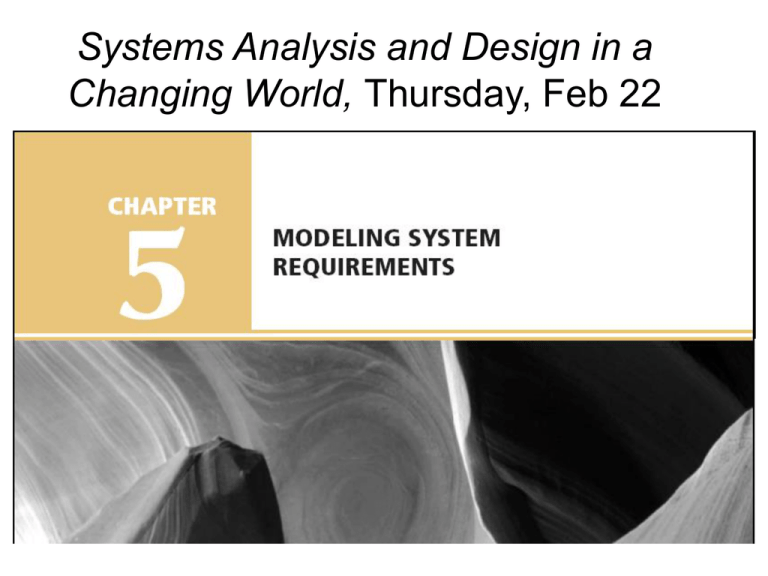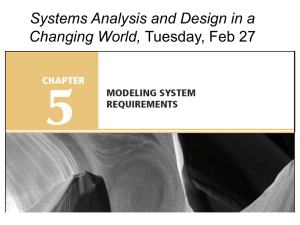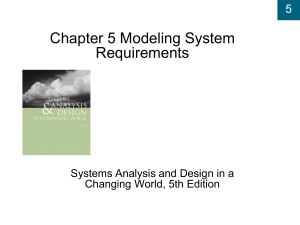Events and Things
advertisement

Systems Analysis and Design in a Changing World, Thursday, Feb 22 Today’s Schedule 2 Using Events for Requirements Using “Things” for Requirements For Tuesday, February 27 Finish Reading Chapter 5, ERDs and Class Diagrams Try out ERDs in Visual Paradigm Recall … Where You Are Headed 3 Events Affecting a Charge Account Processing System that Lead to Use Cases 4 Identifying Events 5 Can be difficult to determine Often confused with conditions and responses May be useful to trace a transaction’s life cycle Certain events left to design phase – System controls to protect system integrity – Perfect technology assumption defers events Sequence of “Transactions” for One Specific Customer >> Many Events 6 Defer Some Events Until Design 7 Event Table: Catalog of Information about Each Use Case How do the “events” in Activity Diagram fit? 8 “Things” in Problem Domain Define system requirements by understanding system information that needs to be stored Store information about things in the problem domain that people deal with when they do their work Analysts identify these types of things by considering each use case in the event table – 9 What things does the system need to know about and store information about? Types of Things 10 Developing an Initial List of Things 11 Step 1: Using the event table and information about each use case, identify all nouns Step 2: Using other information from existing systems, current procedures, and current reports or forms, add items or categories of information needed Step 3: Refine list and record assumptions or issues to explore Questions for Refining List Should you include it? – – – Should you exclude it? – – – Synonym for another thing already in list? Is it really an output? Input that results in recording info already in list? Should you research it? – – 12 A unique thing system needs to know about? Inside scope of this system? Need to remember more than one of these? Is it a characteristic of another “thing”? What if assumptions change, is it still needed? “Things” have … Relationship – – – Naturally occurring association among specific things Occur in two directions Number of associations is cardinality or multiplicity Attribute (characteristic) – 13 Binary, unary, ternary, n-ary One specific piece of information about a thing Cardinality/Multiplicity of Relationships 14 Attributes and Values Identifier or Key – Attribute that Uniquely identifies the “thing” 15 Data Entities 16 Things system needs to store data about in traditional IS approach Modeled with entity-relationship diagram (ERD) Requirements model used to create the database design model for relational Objects do the work in a system and store Objects information in the object-oriented approach Objects have behaviors and attributes – – – 17 Class – type of thing Object – each specific thing Methods – behaviors of objects of the class Objects contain values for attributes and methods for operating on those attributes An object is encapsulated – a self-contained unit Data Entities Compared with Objects (Figure 5-22) 18 The Entity-Relationship Diagram (ERD) 19 Cardinality Symbols of Relationships for ERD 20 Expanded ERD with Attributes Shown 21 Customers, Orders, and Order Items 22 ERD with Many-to-Many Relationship 23 Many-to-Many Relationship Converted to Associative Entity to Store Grade Attribute 24 RMO Customer Support System ERD (Figure 5-29) 25 Now you try it … 26 Case Study: (Page 194-5) The Spring Breaks ‘R’ Us Travel Service Booking System #1 Events and event Table #2 Data Entities and their relationships For Tuesday, February 27 27 For Tuesday, February 27 Finish Reading Chapter 5, ERDs and Class Diagrams Try out ERDs in Visual Paradigm











